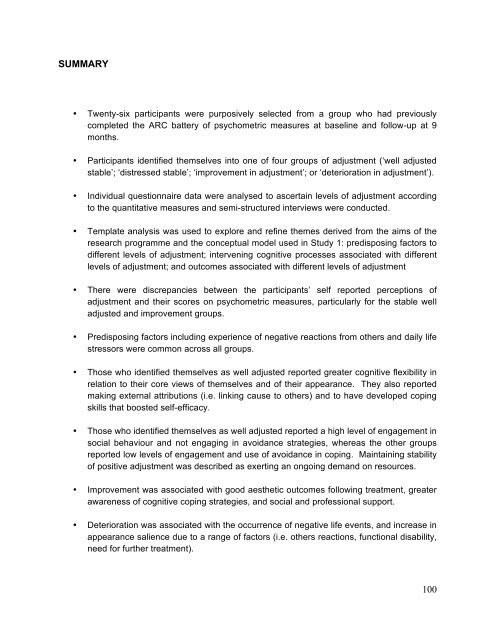Download the report - The Healing Foundation
Download the report - The Healing Foundation
Download the report - The Healing Foundation
You also want an ePaper? Increase the reach of your titles
YUMPU automatically turns print PDFs into web optimized ePapers that Google loves.
SUMMARY<br />
• Twenty-six participants were purposively selected from a group who had previously<br />
completed <strong>the</strong> ARC battery of psychometric measures at baseline and follow-up at 9<br />
months.<br />
• Participants identified <strong>the</strong>mselves into one of four groups of adjustment (‘well adjusted<br />
stable’; ‘distressed stable’; ‘improvement in adjustment’; or ‘deterioration in adjustment’).<br />
• Individual questionnaire data were analysed to ascertain levels of adjustment according<br />
to <strong>the</strong> quantitative measures and semi-structured interviews were conducted.<br />
• Template analysis was used to explore and refine <strong>the</strong>mes derived from <strong>the</strong> aims of <strong>the</strong><br />
research programme and <strong>the</strong> conceptual model used in Study 1: predisposing factors to<br />
different levels of adjustment; intervening cognitive processes associated with different<br />
levels of adjustment; and outcomes associated with different levels of adjustment<br />
• <strong>The</strong>re were discrepancies between <strong>the</strong> participants’ self <strong>report</strong>ed perceptions of<br />
adjustment and <strong>the</strong>ir scores on psychometric measures, particularly for <strong>the</strong> stable well<br />
adjusted and improvement groups.<br />
• Predisposing factors including experience of negative reactions from o<strong>the</strong>rs and daily life<br />
stressors were common across all groups.<br />
• Those who identified <strong>the</strong>mselves as well adjusted <strong>report</strong>ed greater cognitive flexibility in<br />
relation to <strong>the</strong>ir core views of <strong>the</strong>mselves and of <strong>the</strong>ir appearance. <strong>The</strong>y also <strong>report</strong>ed<br />
making external attributions (i.e. linking cause to o<strong>the</strong>rs) and to have developed coping<br />
skills that boosted self-efficacy.<br />
• Those who identified <strong>the</strong>mselves as well adjusted <strong>report</strong>ed a high level of engagement in<br />
social behaviour and not engaging in avoidance strategies, whereas <strong>the</strong> o<strong>the</strong>r groups<br />
<strong>report</strong>ed low levels of engagement and use of avoidance in coping. Maintaining stability<br />
of positive adjustment was described as exerting an ongoing demand on resources.<br />
• Improvement was associated with good aes<strong>the</strong>tic outcomes following treatment, greater<br />
awareness of cognitive coping strategies, and social and professional support.<br />
• Deterioration was associated with <strong>the</strong> occurrence of negative life events, and increase in<br />
appearance salience due to a range of factors (i.e. o<strong>the</strong>rs reactions, functional disability,<br />
need for fur<strong>the</strong>r treatment).<br />
100


